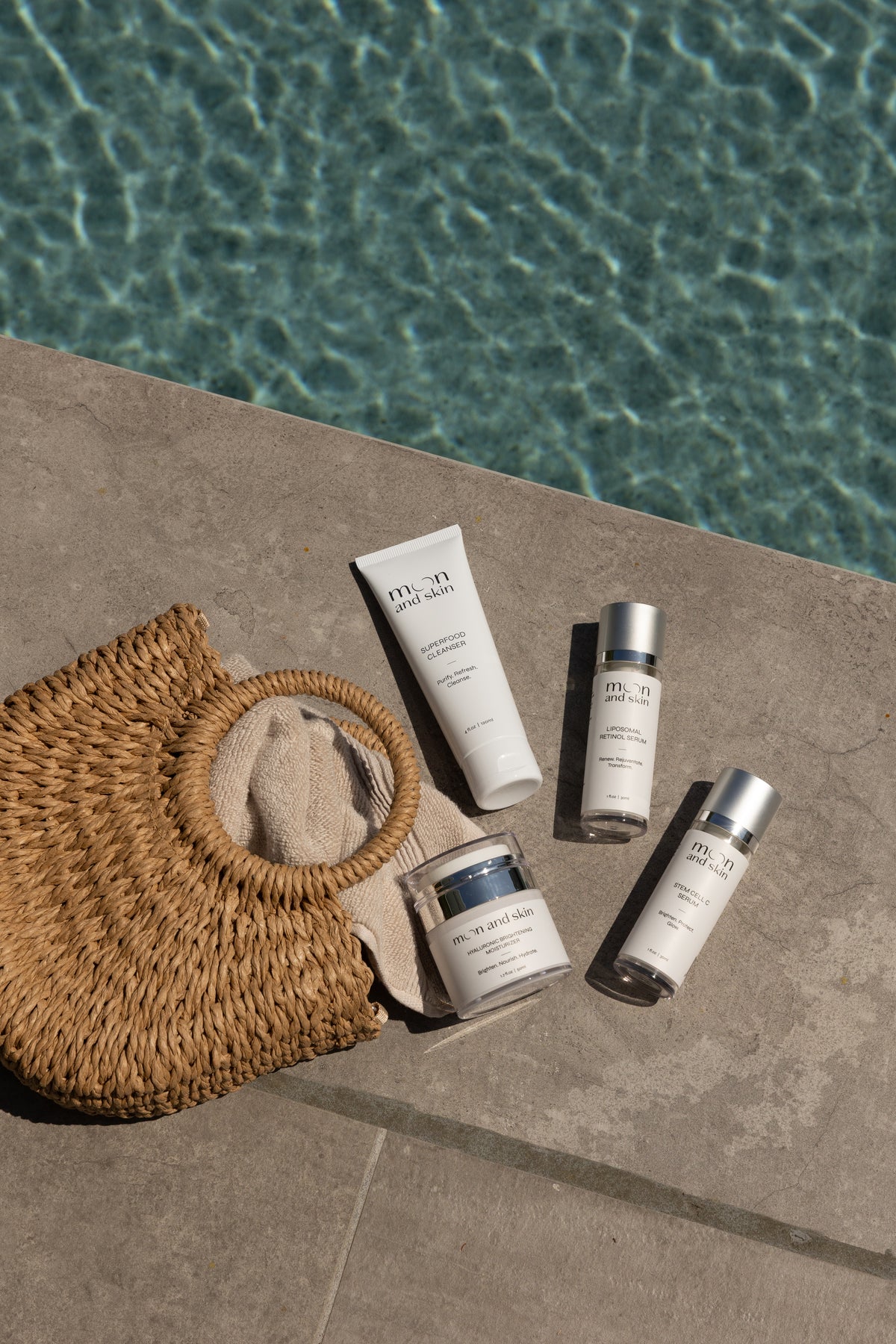Table of Contents
Introduction
Have you ever stood in front of your skincare shelf, pondering the best way to maximize the potential of your serums? You're not alone. Serums are the powerhouses of skincare, but the question arises: can you use multiple serums in a skincare routine? With the ever-evolving nature of skincare, understanding how to layer these concentrated formulations can feel overwhelming.
Serums contain high concentrations of active ingredients designed to target specific skin concerns, such as hydration, brightening, and anti-aging. As our understanding of skin health deepens, so too does our appreciation for the benefits of combining formulations to create a tailored routine. The good news is that, yes, you can use multiple serums, but there are important considerations to ensure you're getting the most out of each product without overwhelming your skin.
In this blog post, we will explore the ins and outs of using multiple serums in your skincare routine, including how to choose compatible ingredients, the order of application, and tips for maximizing the effectiveness of your regimen. Together, we will break down the specifics to empower you to make informed choices for your skin.
Understanding Serums
What Are Serums?
Serums are lightweight, fast-absorbing liquids designed to deliver potent active ingredients directly to the skin. Unlike traditional moisturizers, which primarily serve to hydrate and protect the skin's surface, serums penetrate deeper layers, addressing a variety of skin concerns effectively. They are formulated with smaller molecules that allow for better absorption, making them ideal for targeting issues like fine lines, uneven skin tone, and dullness.
Key Benefits of Using Serums
- Targeted Treatment: Serums can address specific skin concerns, such as dark spots, dehydration, or signs of aging. For instance, our Stem Cell C Serum is formulated with stable, acne-safe vitamin C to brighten and protect the skin.
- High Concentration of Active Ingredients: Because serums are packed with powerful actives, they can provide noticeable results in a shorter amount of time compared to other types of skincare products.
- Versatility: Serums can be easily incorporated into various skincare routines, allowing for customization based on individual skin needs.
Choosing the Right Serums
When selecting serums, consider your skin type and the specific concerns you want to address. Here are some common ingredients and their benefits:
- Hyaluronic Acid: This powerhouse hydrator draws moisture into the skin and is perfect for those with dry or dehydrated skin. Our Hyaluronic Brightening Moisturizer also contains hyaluronic acid to provide deep hydration and a brightening effect.
- Vitamin C: Known for its brightening and antioxidant properties, vitamin C can help improve skin tone and reduce signs of aging.
- Retinol: A potent anti-aging ingredient that promotes cell turnover, retinol can help diminish fine lines and improve skin texture.
- Peptides: These amino acids support skin structure and can enhance hydration and elasticity.
How to Layer Multiple Serums
The Importance of Ingredient Compatibility
One of the most critical aspects of using multiple serums is ensuring that the ingredients are compatible. Some ingredients work synergistically to enhance each other's benefits, while others can cause irritation or diminish efficacy when combined. Here are some essential pairings to consider:
- Hyaluronic Acid and Vitamin C: Combining these two can help hydrate the skin while brightening it, making for a powerful morning duo.
- Peptides and Retinol: Using peptides alongside retinol can reduce irritation and support the skin barrier, making them a perfect nighttime pairing.
Conversely, some combinations should be avoided:
- Retinol and AHAs/BHAs: Using these potent exfoliants together can lead to increased sensitivity.
- Vitamin C and AHAs/BHAs: The pH levels of AHAs can destabilize vitamin C, making it less effective.
Order of Application
The general rule for layering serums is to apply them from the thinnest to the thickest consistency. Here's a step-by-step guide for optimal application:
- Cleanse: Start with a gentle cleanser, such as our Superfood Cleanser, to remove impurities and prepare your skin for the serum.
- Apply Toner (Optional): If you use a toner, apply it before your serums to help balance your skin's pH.
- Apply Serums: Start with the thinnest serum first. For instance, if you're using a hyaluronic acid serum followed by a vitamin C serum, apply the hyaluronic acid first to lock in moisture.
- Wait Time: Allow each serum to absorb fully before applying the next one. This usually takes about 1-2 minutes.
- Moisturize: Finish with a moisturizer to seal in the benefits of the serums. Our Hyaluronic Brightening Moisturizer is an excellent choice for this step.
- Sunscreen (AM Routine): Never forget to apply sunscreen during the day to protect your skin from harmful UV rays.
How Many Serums Can You Use?
While the exact number of serums can vary based on individual preferences and skin needs, we recommend using no more than two to three serums at a time. This prevents overwhelming your skin and ensures that each ingredient can be effectively absorbed. If you feel the need to incorporate more, consider alternating products—using different serums on different days or within your AM and PM routines.
Key Takeaways from Layering Serums
- Choose serums with compatible ingredients.
- Apply serums from thinnest to thickest.
- Limit the number of serums to two or three for optimal results.
- Allow time for absorption between applications.
Maximizing Your Serum Routine
Consistency is Key
To see the best results from your serums, consistency is crucial. Regular application allows the active ingredients to build up in the skin, leading to noticeable improvements over time. Establishing a skincare routine that you can stick to daily will help you achieve your desired results.
Adjusting to Your Skin's Needs
As we navigate different phases of life, our skin's needs may change. Factors such as stress, diet, climate, and hormonal fluctuations can impact our skin. Therefore, it's essential to stay attuned to your skin's signals and adjust your serum choices accordingly.
For instance, if your skin feels particularly dry in winter, incorporating a hydrating serum like hyaluronic acid can provide immediate relief. Alternatively, if you're experiencing breakouts, a serum with salicylic acid or niacinamide may be more beneficial.
Incorporating Other Skincare Products
While serums are potent, they work best as part of a comprehensive skincare routine. Complement your serums with other products to enhance their effects:
- Cleansers: Begin with a gentle, nourishing cleanser, like our Superfood Cleanser, to prepare the skin for serum absorption.
- Moisturizers: A good moisturizer, such as our Hyaluronic Brightening Moisturizer, helps lock in the benefits of your serums and keeps your skin hydrated.
- Sunscreen: Always protect your skin from UV damage during the day, especially if you use active ingredients like retinol or vitamin C.
Common Mistakes to Avoid
- Overloading with Actives: Using too many potent ingredients at once can irritate your skin. Stick to a few targeted serums that address your primary concerns.
- Neglecting Patch Testing: Before committing to a new serum, always patch test to ensure your skin doesn’t react negatively.
- Ignoring the Order of Application: Applying products in the wrong order can hinder their effectiveness. Follow the thin-to-thick rule for the best results.
- Not Giving Time to Absorb: Rushing through your routine can lead to pilling and ineffective application. Allow your skin to absorb each serum fully before moving on.
- Forgetting Sunscreen: If you’re using active ingredients, protecting your skin from the sun is essential to prevent irritation and potential damage.
The Role of Our Products
At Moon and Skin, we believe in providing clean and thoughtful skincare for every phase of life. Our serums are designed to work harmoniously with your skin, enhancing its natural beauty. For those looking to brighten and hydrate, our Stem Cell C Serum is a stellar choice, while our Liposomal Retinol Serum is perfect for those seeking to address signs of aging.
Conclusion
Navigating the world of serums and layering can be a rewarding journey, leading to healthier, more radiant skin. By understanding the right combinations, application order, and how to maximize your routine, you can harness the power of multiple serums effectively.
Remember, every skin journey is unique, and what works for one person may not work for another. We encourage you to experiment with your serums, listen to your skin, and adapt your routine as needed.
If you're ready to build a complete skincare routine, check out our Bundle & Save collection, which combines our best-selling products for a comprehensive approach that targets multiple concerns.
FAQ
Can I use different serums for morning and night routines?
Yes! It's a great idea to tailor your serums based on your skin's needs at different times of the day. For example, you might choose a vitamin C serum in the morning for its brightening and protective properties, and a retinol serum at night for its anti-aging benefits.
How long should I wait between applying different serums?
Allow 1-2 minutes for each serum to absorb fully into the skin before applying the next one. This ensures that each product can penetrate effectively.
Can I layer more than three serums?
While it’s possible to layer more than three serums, we recommend limiting your use to two or three to avoid overwhelming your skin and ensure each ingredient can work effectively.
Do I need to use a serum if I have a good moisturizer?
While a good moisturizer is essential, serums provide concentrated active ingredients that tackle specific skin issues more effectively. They can complement your moisturizer for optimal results.
What should I do if my skin reacts negatively to a serum?
If you experience irritation, redness, or discomfort, discontinue use immediately. Patch testing new products before full application can help avoid adverse reactions.







